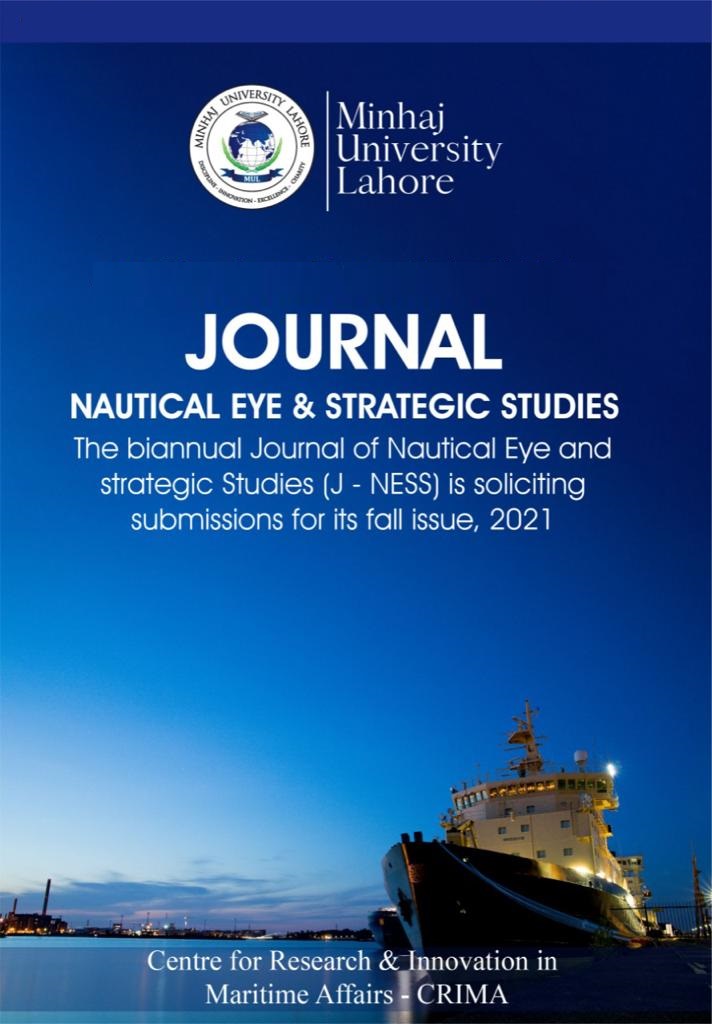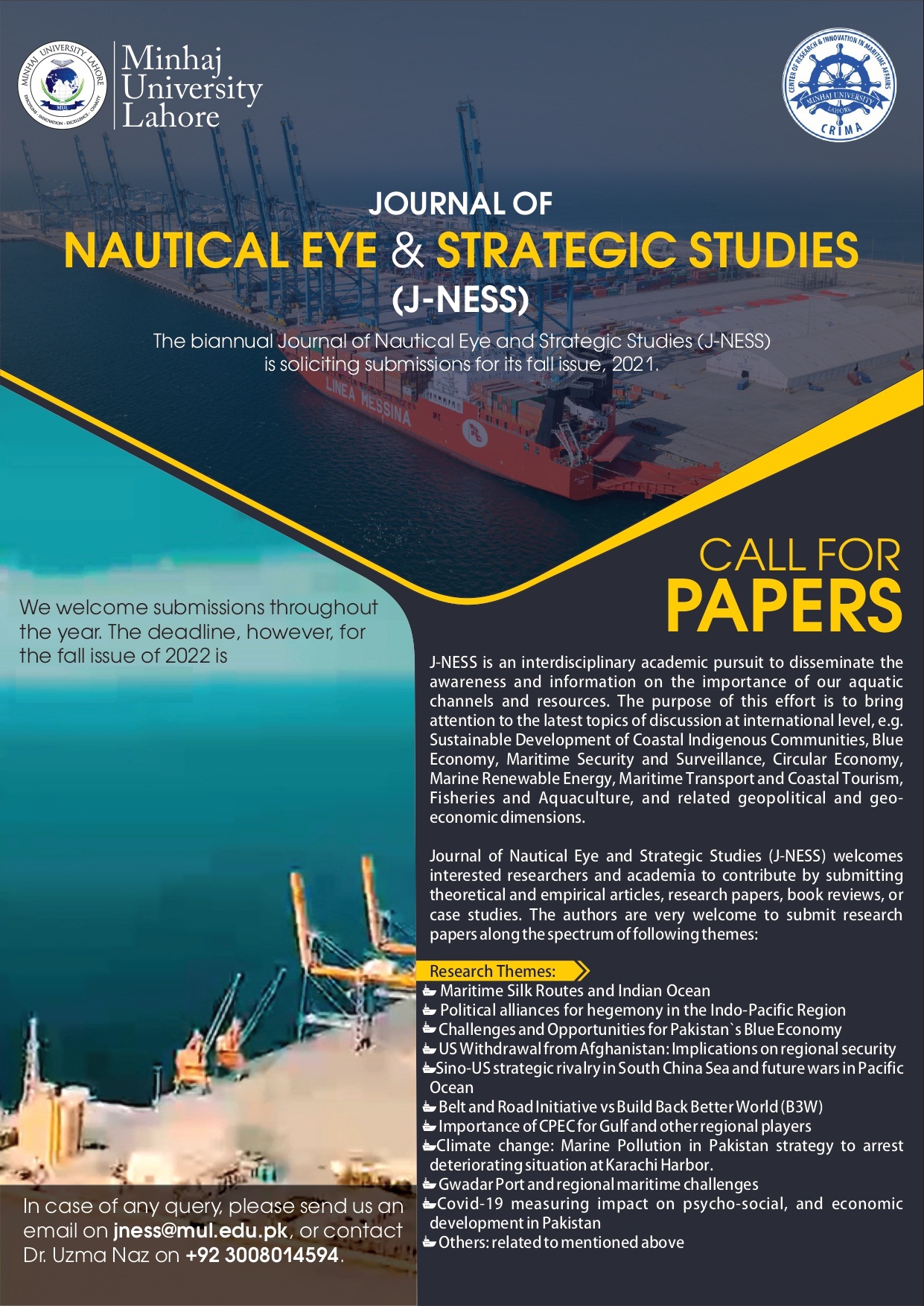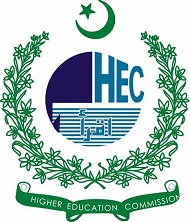Exploring Seabed Mining in the Indian Ocean Region (IOR): Policy and Governance Insights for Pakistan
DOI:
https://doi.org/10.58932/MULG0057Keywords:
Deep seabed mining, Green technologies, Strategic resources, Blue economy, Sustainable mining practices, International Seabed Authority (ISA)Abstract
Deep Seabed Mining (DSM) has emerged as a critical avenue in the Indian Ocean Region (IOR), primarily for key stakeholders like China and India. These nations have already identified DSM as a way to secure critical energy minerals and metals – necessary for green technology transformation, which could boost their economies and industrial capabilities. Despite having significant maritime territorial claims under UNCLOS, Pakistan is lagging behind in utilizing such an opportunity. This research paper aims to examine the deep seabed exploration and mining strategies of China and India to identify actionable policies for Pakistan to advance in DSM industry. This research relies on extensive qualitative and thematic analysis to analyze the technological, legal and environmental frameworks these nations have implemented to gain upper edge in DSM capabilities. Furthermore, this study identifies gaps that challenge Pakistan in its healthy participation in DSM program. Subsequently, the findings reveal that China’s centralized governance approach contrasts with India’s multi-institutional strategy. Based on these models, Pakistan should follow a coordinated step-by-step approach. This piece of research puts forth recommendations to reform the policy framework, enhance technological advancement through international collaborations for a balanced approach to initiate its seabed mining industry and addressing both environmental and economic concerns.
References
Agarwal, C. D. (2016). Deep Seabed Mining in the Indian Ocean Region: Economic and Strategic Dimension. National Maritime Foundation. Retrieved from: https://maritimeindia.org/View%20Profile/637030012543247123.pdf
Anderson, D. H. (1995). Resolution and Agreement Relating to the Implementation of Part XI of UNCLOS: A General Assessment. Max-Planck-Institut für ausländisches öffentliches Recht und Völkerrecht. Retrieved from: https://www.zaoerv.de/55_1995/55_1995_2_a_275_289.pdf
Atkinson, R. D. (2024, September). China Is Rapidly Becoming a Leading Innovator in Advanced Industries. Information Technology and Information Foundation. Retrieved from: https://itif.org/publications/2024/09/16/china-is-rapidly-becoming-a-leading-innovator-in-advanced-industries/
Baird, Stephen L. (2006). Deep Sea Exploration: Earth's Final Frontier. The Technology Teacher, 65(4), 14-18.
Banerjee, S. (2023, September). Samudrayaan Mission: India intensifies the race for clean energy through deep-seabed mining. The Economic Times. Retrieved from: https://energy.economictimes.indiatimes.com/news/renewable/samudrayaan-mission-india-intensifies-the-race-for-clean-energy-through-deep-seabed-mining/103796325
Bhatti, M. B. A., & Durrani, M. K. (2024). The effect of project managers’ competencies on project success with mediating role of project stakeholders’ engagement: A case of IT sector. Journal of Management Info, 11(1), 51-73.
Bhutta, Z. (2017, May). Govt plans to stop using furnace oil, diesel in power production. Express Trinbune. Retrieved from: https://tribune.com.pk/story/1411708/govt-plans-stop-using-furnace-oil-diesel-power-production
DEEP-SEA MINING. IUCN Issue 2022. Retrieved from: https://iucn.org/sites/default/files/2022-07/iucn-issues-brief_dsm_update_final.pdf
International Seabed Authority. Britannica, T. Editors of Encyclopaedia. Retrieved from: https://www.britannica.com/topic/International-Seabed-Authority
Bureau, P. I. (2023, August). Net zero emissions target. Retrieved from Ministry of Environment, Forest and Climate Change, Government of India : https://pib.gov.in/PressReleaseIframePage.aspx?PRID=1945472
Chen, C. Z. (2020). China’s Domestic Law on the Exploration and Development of Resources in Deep Seabed Areas. In C. Banet, The Law of the Seabed: Access, Uses, and Protection of Seabed Resources: 90 (Publications on Ocean Development) (pp. 335–370). Brill, Nijhoff.
Cheng, E. (2024, August). China’s exporters enjoyed the benefits of a weak yuan. Now that’s changing and cutting into profits. CNBC. Retrieved from: https://www.cnbcafrica.com/2024/chinas-exporters-enjoyed-the-benefits-of-a-weak-yuan-now-thats-changing-and-cutting-into-profits/
Chughtai, M. A., Bhatti, M. B. A., & Naqvi, I. H. Ethics before Trust in Organization Public Relationships (OPRs): A Review of Real Estate Organizations.
Council, T. S. (2014, September). State Oceanic Administration. The People Republic of China, The State Council. Retrieved from: http://english.www.gov.cn/state_council/2014/10/06/content_281474992889983.htm
Dale, A. a. (2015). Tidal mixing processes amid small-scale, deep-ocean topography. Geophysical Research Letters, 484-491.
Darlene Trew Crist, R. O. (2013). Census of Marine Life. In Elsevier, Reference Module in Life Sciences, Encyclopedia of Biodiversity (2nd Edition).
David Michel, H. F. (2012). Natural Resources in the Indian Ocean: Fisheries and Minerals. In R. S. David Michel, Indian Ocean Rising: Maritime Security and Policy Challenges (pp. 103-113). Stimson Center.
Desk, M. (2024). Pakistan struggles to attract offshore oil and gas investments amid security and economic challenges. Profit. Retrieved from: https://profit.pakistantoday.com.pk/2024/07/19/pakistan-struggles-to-attract-offshore-oil-and-gas-investments-amid-security-and-economic-challenges/
Diaz, C. (2023). 1 in 7 cars sold globally now is electric. World Economic Forum. Retrieved from: https://www.weforum.org/agenda/2023/03/ev-car-sales-energy-environment-gas/#:~:text=Global%20sales%20of%20electric%20cars,International%20Energy%20Agency%20(IEA).
Establishment of the Outer Limits of Continental Shelf of Pakistan. (n.d.). United Nations. Retrieved from: https://www.un.org/depts/los/clcs_new/submissions_files/pak29_09/pak2009executivesummary.pdf
Fouquet, Y. &. (2016). Gold in polymetallic sulfide deposits formed by hydrothermal processes at mid-ocean ridges. Gold in polymetallic sulfide deposits formed by hydrothermal processes at mid-ocean ridges., 16.
Gales, P. (2023). How polymetallic sulphide deposits form. Deep Sea Mining. Retrieved from: https://deepseamining.ac/how_sulphide_deposits_form#gsc.tab=0
Gales, P. (2023). International Seabed Authority. ISA. Retrieved from: https://deepseamining.ac/article/3#gsc.tab=0
German, C. R. (2016). Hydrothermal exploration of mid-ocean ridges: where might the largest sulfide deposits be forming? Chemical Geology, 114-126.
Government of Pakistan. (2022). Pakistan Energy Outlook Report 2021-2030.
Guobin Zhang, P. Z. (2016). A new step forward: Review of China's 2016 legislation on international seabed area exploration and exploitation. Marine Policy, 244-255.
H.N. Siddiquie, A. G. (1984). Superficial mineral resources of the Indian Ocean. Deep Sea Research Part A. Oceanographic Research Papers, 763-812 .
Halfar, J. &. (2007). Danger of deep-sea mining. Science, 987.
Hein, J. e. (2013). Cobalt-rich ferromanganese crusts: global distribution, composition, origin and research activities. Island Arc, 301-308.
International Energy Ageny. Net Zero by 2050. https://www.iea.org/reports/net-zero-by-2050
International Energy Ageny. Introducing the Critical Minerals Policy Tracker. Retrieved from IEA: https://www.iea.org/reports/introducing-the-critical-minerals-policy-tracker
International Energy Ageny. (2023, February). Hydrocarbon Exploration and Licensing Policy (HELP). Retrieved from: https://www.iea.org/policies/16980-hydrocarbon-exploration-and-licensing-policy-help
International Energy Ageny. (2023). Overall supply and demand of lithium for batteries by sector, 2016-2022. Retrieved from: https://www.iea.org/data-and-statistics/charts/overall-supply-and-demand-of-lithium-for-batteries-by-sector-2016-2022
Ilya Epikhin, C. S. (2024). Seabed mining: A $20 trillion opportunity-The future of resource extraction? Arthur Little.
International Seabed Authority. (2021). The Contribution of the International Seabed Authority to the Achievement of the 2030 Agenda for Sustainable Development.
ISA. (2024, January). Retrieved from ISA: https://www.isa.org.jm/news/the-government-of-india-submits-two-applications-for-approval-of-plans-of-work-for-seabed-exploration-in-the-indian-ocean/
ISA. (2024). Status of Exploration Activities in the Area. https://www.isa.org.jm/wp-content/uploads/2024/07/ISA_Status_of_exploration_activities_June_2024.pdf
Jawad, S., Naveed, H., & Akram, M. B. (2020). Academic Performance of Enrolled Students in the University of Lahore, Pakistan. Quest Journal of Management and Social Sciences, 2(2), 357–365.
John Coyne, J. B. (2024, March). China’s dominance over critical minerals poses an unacceptable risk. The Interpreter, The Lowy Institute. Retrieved from: https://www.lowyinstitute.org/the-interpreter/china-s-dominance-over-critical-minerals-poses-unacceptable-risk#:~:text=China%20currently%20controls%20much%20of,metals%20and%20seven%20industrial%20minerals.
Karan Bhuwalka, E. O. (2024, June). Nickel Market Dynamics and the Security of the Battery Supply Chain. Texas University Blogs. Retrieved from: https://sites.utexas.edu/mineralstransition/files/2024/06/Nickel_Memo_Bhuwalka_Olivetti-Google-Docs.pdf
Khadka, N. S. (2024, March). India in undersea race to mine world’s battery metal. BBC News. Retrieved from: https://www.bbc.com/news/world-asia-india-68613351
Koschinsky, A. e. (2014). Seafloor hydrothermal systems and the delivery of metals to the oceans. Seafloor Hydrothermal Systems, 1-18.
Kuhn, T. W. (2017). Composition, Formation, and Occurrence of Polymetallic Nodules. In R. Sharma, Deep-Sea Mining. Springer, Cham.
Kuo, L. (2019). China is set to dominate deep sea and its wealth for rare metals. The Washington Post. Retrieved from: https://www.washingtonpost.com/world/interactive/2023/china-deep-sea-mining-military-renewable-energy/
Lam, R. (2024, August). China Minmetals and BPHD to conduct deep-sea mining trials in Pacific in 2025; experts warn of potential. Business and Human Rights Resource Centre. Retrieved from: https://www.business-humanrights.org/my/%E1%80%9E%E1%80%90%E1%80%84/china-state-owned-enterprises-plan-deep-sea-mining-trials-amid-environmental-concerns-experts-warn-of-potential-ecosystem-damage/
Lopez, J. (2023). Deep-sea mining: finding a balance between resource extraction and environmental preservation. Medium. Retrieved from: https://medium.com/@joellopezs/deep-sea-mining-finding-a-balance-between-resource-extraction-and-environment-preservation-c40fd0f79083
Malik, T. (2024, August). Coal consumption to double by 2030: report. Medium. Retrieved from: https://www.thenews.com.pk/print/1215327-coal-consumption-to-double-by-2030-report
Markus H.A. Piro, K. L. (2020). Mining and milling. In M. H. Piro, Advances in Nuclear Fuel Chemistry (pp. 315-329). Woodhead Publishing Series in Energy.
McKie, R. (2023, March). Deep-sea mining for rare metals will destroy ecosystems, say scientists. The Guardian. Retrieved from: https://www.theguardian.com/environment/2023/mar/26/deep-sea-mining-for-rare-metals-will-destroy-ecosystems-say-scientists
Mehmood, Z. (2024). Untapped economic potential of Pakistan’s EEZ. The Express Tribune. Retrieved from: https://tribune.com.pk/story/2445297/untapped-economic-potential-of-pakistans-eez
Mewes K, M. J. (2014). The impact of depositional and biogeochemical processes on small scale variations in nodule abundance in the Clarion–Clipperton Fracture Zone. Deep Sea Research-I, Elsevier, 125-141.
International Seabed Authority. (2006). Mining Cobalt-rich Ferromanganese Crusts. Retrieved from: https://www.isa.org.jm/wp-content/uploads/2022/08/2006sulpcrusts-web_0.pdf
MSrivastava. (2023). India’s Deep Sea Mining Endeavours: A Search for Climate Solutions in Deep Waters. Manohar Parikar Institute for Defense Studies and Analysis. Retrieved from: https://www.idsa.in/issuebrief/indias-deep-sea-mining-endeavours-MSrivastava-270923
Najafizada, E. (2023, September). Deep Sea Submersible to Take India Four Miles Underwater. Bloomberg. Retrieved from: https://www.bloomberg.com/news/articles/2023-09-12/titan-like-submersible-to-take-india-four-miles-underwater
IEA News. (2023). The energy world is set to change significantly by 2030, based on today’s policy settings alone. Retrieved from: https://www.iea.org/news/the-energy-world-is-set-to-change-significantly-by-2030-based-on-today-s-policy-settings-alone
Nidhi. (2023, November). Mineral Resources of the Indian Ocean. The Geostrata. Retrieved from: https://www.thegeostrata.com/post/mineral-resources-of-the-indian-ocean
NIO. (1982). Annual Report (1982). National Institute of Oceanography, India.
Oliver Ashford, J. B. (2024). What We Know About Deep-sea Mining — and What We Don’t. World Resource Institute. Retrieved from: https://www.wri.org/insights/deep-sea-mining-explained
Persand, S. (2005). A Practical Overview of Article 76 of the United Nations. Mauritius Oceanography Institute.
PIB. (2017). India’s Exclusive Rights to Explore Polymetallic Nodules from Central Indian Ocean Seabed Basin Extended by Five Years. Retrieved from Ministry of Earth Science, Government of India: https://pib.gov.in/newsite/PrintRelease.aspx?relid=170138
Prasad, M. S. (2007). Indian Exploration for Polymetallic Nodules in the Central Indian Ocean. National Institute of Oceanography Dona Paula. Retrieved from: https://drs.nio.res.in/drs/bitstream/handle/2264/754/Refresher_Course_Mar_Geol_Geophys_2007_Lecture_Notes_52.pdf?sequence=2&isAllowed=y
Shahid Sattar, M. M. (2024, January). Pakistan’s energy use: high inefficiency and distorted consumption. Business Recorder. Retrieved from: https://www.brecorder.com/news/40282499
Singh, P. (2024, June). Deep seabed mining: A general policy at the International Seabed Authority? EJIL Talk. Retrieved from: https://www.ejiltalk.org/deep-seabed-mining-a-general-policy-at-the-international-seabed-authority/
Singh, P. A. (2020). Deep Seabed Mining and Sustainable Development Goal 14. In A. M. Walter Leal Filho, Life Below Water. Springer Links.
Mint. (2023, May). Deep ocean mission to drive growth of ‘Blue Economy. Retrieved from: https://www.livemint.com/news/india/deep-ocean-mission-to-drive-growth-of-blue-economy-jitendra-singh-11683730365698.html
Kuhn, A. W. (2018). Composition, Formation, Occurrence of Polymetalic Nodules. Deep-Sea Mining: Resource Potential, Technical and Environmental Considerations.
Tong, Z. (2024, July). Chinese deep-sea mining vehicle that could put entire South China Sea in reach tested. South China Morning Post. Retrieved from: https://www.scmp.com/news/china/science/article/3270047/chinese-team-tests-deep-sea-mining-vehicle-could-put-entire-south-china-sea-reach
UNCLOS (1982). (n.d.). Retrieved from Ocean and Laws of Sea: https://www.un.org/depts/los/convention_agreements/texts/unclos/UNCLOS-TOC.htm
Varadhan, S. (2019, June). India plans to add 500 GW renewable energy by 2030: government. Reuters. Retrieved from: https://www.reuters.com/article/world/india-plans-to-add-500-gw-renewable-energy-by-2030-government-idUSKCN1TQ1QW/
WEF. (2023, November). Meeting at Part III of the 28th Session of the International Seabed Authority. Retrieved from: https://wwfint.awsassets.panda.org/downloads/wwf-global-policy-brief-international-seabed-authority-oct-nov-2023.pdf
Xiangxin Xu, G. Z. (2015). China’s Deep Seabed Law: Towards “Reasonably Appropriate” Environmental Legislation for Exploration and Exploitation of Deep Sea Minerals in the Area. Asian Yearbook of International Law, 183–201.
Zhixiong, W. (2017). China and the exploitation of deep seabed polymetallic nodules. Marine Policy, 132-135.
Zhong, Y. (2023). China Leads the Race to the Bottom: Deep Sea Mining for Critical Minerals. Wilson Center. Retrieved from: https://www.newsecuritybeat.org/2023/08/china-leads-race-bottom-deep-sea-mining-critical-minerals/
Zhong, Y. (2023, August). China Leads the Race to the Bottom: Deep Sea Mining for Critical Minerals. New Security Beat. Retrieved from: https://www.newsecuritybeat.org/2023/08/china-leads-race-bottom-deep-sea-mining-critical-minerals/
Downloads
Published
How to Cite
Issue
Section
License
Copyright (c) 2025 Journal of Nautical Eye and Strategic Studies

This work is licensed under a Creative Commons Attribution-NonCommercial 4.0 International License.










